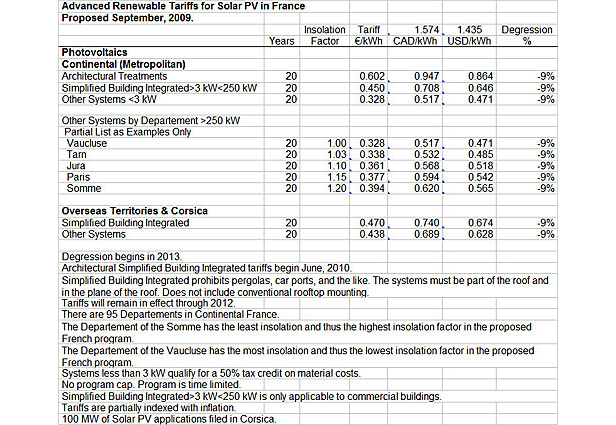For the second time within twelve months the French Government of conservative President Nicolas Sarkozy has proposed raising the feed-in tariff for solar PV in the coming year.
The new provisions are contained in the specific regulations proposed in response to Minister for Energy and the Environment Jean-Louis Borloo’s announcement last November.
The proposed regulations depart both from the current program and from the provisions outlined by Borloo in November 2008 in significant ways.
The draft regulations propose a tariff for a new application category of solar PV used architecturally. The tariff, if approved, will be among the highest, if not the highest in the world for solar PV: €0.602/kWh ($0.95 CAD/kWh, $0.86 USD/kWh). As one would expect, this has created quite a buzz in the solar community.
Potentially more groundbreaking, however, is the French proposal to offer solar PV tariffs for commercial projects (systems greater than 250 kW) differentiated by solar resource intensity.
Wind energy tariffs in both France and Germany have varied by resource intensity since 2000. This would be the world’s first application of the concept to solar PV tariffs.
If successful in the diverse climates of France, the concept could have application in countries spanning continental land masses such as Canada, the U.S., China, and Australia.
In principle, France will pay up to 20 percent more for solar PV generation in the cloudy north than in the sun-drenched south, for example along the Côte d’Azur.
The final tariffs are determined by the application of an insolation factor that varies by departement. For example, systems installed in the southern city of Avignon in the Departement of Vaucluse will receive the base tariff of €0.328/kWh ($0.52 CAD/kWh, $0.47 USD/kWh). In Paris, the tariff is based on an insolation factor of 1.15 times the base tariff or €0.377/kWh ($0.59 CAD/kWh, $0.54 USD/kWh). To the north of Paris in the Departement of the Somme, the insolation factor proposed in the draft regulation reaches a maximum of 1.20 and the tariff rises to €0.394/kWh ($0.62 CAD/kWh, $0.57 USD/kWh).
The maximum proposed tariff in the program is approximately equivalent to that proposed in Ontario for similar systems. There are no tax subsidies in either France or Ontario for projects of this size.
Despite these innovative features and the fact that there is no cap or limit on the program’s size, the proposed regulations reflect uniquely French political preferences, charge critics.
In Germany solar PV tariffs are simply graduated by size. The German Solar Industry Association reports that nearly 30 percent of capacity (~1,500 MW) has been installed on residential rooftops, and another 50 percent (~2,500 MW) installed on farm buildings and multi-family residences.
Thus, say critics, the Tuetonic program is more egalitarian than that in the land of “Liberté, Egalité, Fraternité”.
In contrast to German policy, the proposed French program, will severely limit residential solar systems, charge two of France’s most prominent advocates of solar energy: Hespul and CLER (Comité de Liaison Energie Renouvelables).
Hespul, located in France’s solar city of Lyon, specializes in energy efficiency and solar PV. (Hespul installed the first grid-connected solar PV system in France). CLER is the principal umbrella group representing the renewable energy industry and solar advocates.
The two organizations issued a joint communiqué September 10, 2009 applauding the proposal for its innovative features, but criticizing its shortsightedness. The proposal fell well short of what’s needed, they said, and unduly favors multi-national developers over small distributed generators.
Residential rooftop solar systems are limited to less than 3 kW and the tariff, €0.338 ($0.52 CAD/kWh, $0.47 USD/kWh), is insufficient in much of France, says Hespul’s Marc Jedliczka, even with tax subsidies. He warns that the current proposal will miss reaching the 14 million French rooftops that could use solar.
For its part, CLER characterized the proposed tariffs as “unfair to the many for the benefit of the few.”
Further, the French program has odd twists that limit the effectiveness of solar. In a bow to misplaced aesthetic sentiments, rooftop panels must be in the “plane of the roof”. Often that will mean the panels must be flat and not mounted on racks.
These oddities greatly restrict the solar PV market in France, said Hespul and CLER.
The regulations must be approved by Minister Borloo sometime this fall to take effect in January, 2010.

This post is reprinted from Wind-Works.org.



